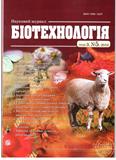ISSN 1995-5537

"Biotechnology" journal Vol. 3, No. 5, 2010
Р. 9-18, Bibliography 66, Russian.
Universal Decimal classification: 577.157.2
MEIZOTHROMBIN, NAMELY A DERIVATE OF PROTHROMBIN
IS A Na+-DEPENDENT ALLOSTERIC ENZYME
M. V. Kolodzeiskaia, E. I. Yusova, T. V. Grinenko
Palladin Institute of Biochemistry of National Academy of Sciences of Ukraine, Kyiv
According to modern conception concerning the mechanism of prothrombin activation, proenzyme and its intermediate form, meizothrombin exist in alternative conformations.The last ones determine splitting of two peptide bonds in the prothrombin molecule, that is necessary for its transformation into thrombin. Prothrombin conformation is optimal to split the bond Arg 320-Ile 321, while meizothrombin conformation is the most suitable to split Arg 271-Thr 272.
In contrast to thrombin, meizothrombin has illdefined procoagulant properties and enhanced anticoagulant activity mediated by thrombomodulin-dependent activation of protein C. Meizothrombin can regulate fibrinolytic process through thrombomodulin-dependent activation of fibrinolysis inhibitor (TAFI).
Similar to thrombin, meizothrombin interacts with fibrinogen, thrombomodulin and protein C. Meizothrombin specificity depends on binding of sodium ions. It was found that specific procoagulant properties of meizothrombin (such as activation of factors V and VIII on the membrane surface) and anticoagulant ones, which are induced by the activation of protein C bound with thrombomodulin, can be regulated by Na+ as an effector of its catalytic function.Besides, Na+ influences on the meizothrombin activity by increasing affinity of ligands towards exosite I and by guidance of prothrombin activation, that leads to thrombin formation directly from the fast form of meizothrombin. Discovery of meizothrombin as Na+-dependent allosteric enzyme can reveal new approaches for regulation its activity and specificity.
Key words: prothrombin, meizothrombin, coagulation factor V, thrombin exosites I and II, Na+ binding , allosteric regulation.
© Palladin Institute of Biochemistry of National Academy of Sciences of Ukraine, 2008

